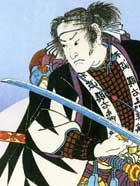
Soul of the Samurai 2005
Distributed by Cinema Guild, 115 West 30th Street, Suite 800, New York, NY 10001; 212-685-6242
Produced by Renascent Films
Director n/a
DVD, color, 46 min.
Jr. High - Adult
Asian Studies, Japan, History
Date Entered: 04/05/2006
Reviewed by Sheila Intner, Professor Emerita, Graduate School of Library & Information Science, Simmons College GSLIS at Mt. Holyoke, South Hadley, MAAmerican viewers may be surprised to learn about the many similarities between the Japanese samurai and their code of bushido and the more familiar European knights and their code of chivalry from this outstanding educational program. It covers the history, development, functions, social, and spiritual life of samurai warriors during the Edo period in Japan.
Bushido, a unique Japanese blend of Confucianism and Zen Buddhism that was not without conflicting elements, dictated the lifestyle and behavior of the samurai. It was filled with sacrifice and ritual. Loyalty to his master was the samurai’s most important attribute. Maintaining his personal honor and the honor of his master through proper use his sword was his goal. The beauty and strength of the samurai’s curved sword embodied his very soul.
The rise of the samurai class in medieval Japan and its role during the period of Japanese history when the country was transformed from a group of warring feudal states to a unified nation under one Shogun are described in some detail here. Instead of using costumed actors or excerpts from samurai films for its background, Soul of the Samurai illustrates its subject with excellent colorful renderings of antique woodcuts, sure to capture the attention of viewers of all ages. The opening of Japan’s borders to Westerners and adoption of firearms in place of swords ultimately brought the samurai period to an end, but its spirit continues to permeate Japanese culture in other forms.
Technically, the production is well-crafted, with excellent pacing and a good balance of artistic renderings of the stories of the samurai, their equipment, and activities, including battle scenes, and live action interviews with two knowledgeable commentators: Michael Zomber, an author who has studied the samurai; and Rev. Kensho Furuya of Los Angeles, California, head of the Aikido Center in that city. Alternately, these experts explain the meaning and development of the samurai culture and its sword, armor, and duties as well as the spiritual nature of bushido with its rigid moral code. The voiceover narration is articulated clearly and interestingly.
A minor drawback is that nothing appeared to be recorded on the disc other than the main program. Opportunities for additional features, such as views of museum artifacts, paintings, etc., could add to the program’s overall impact.
Soul of the Samurai can be a valuable component in collections supporting study of Japanese history and culture, particularly during the Edo and pre-Edo periods, when the samurai flourished, as well as for more specific explorations of the samurai warrior and his world.
Highly recommended.